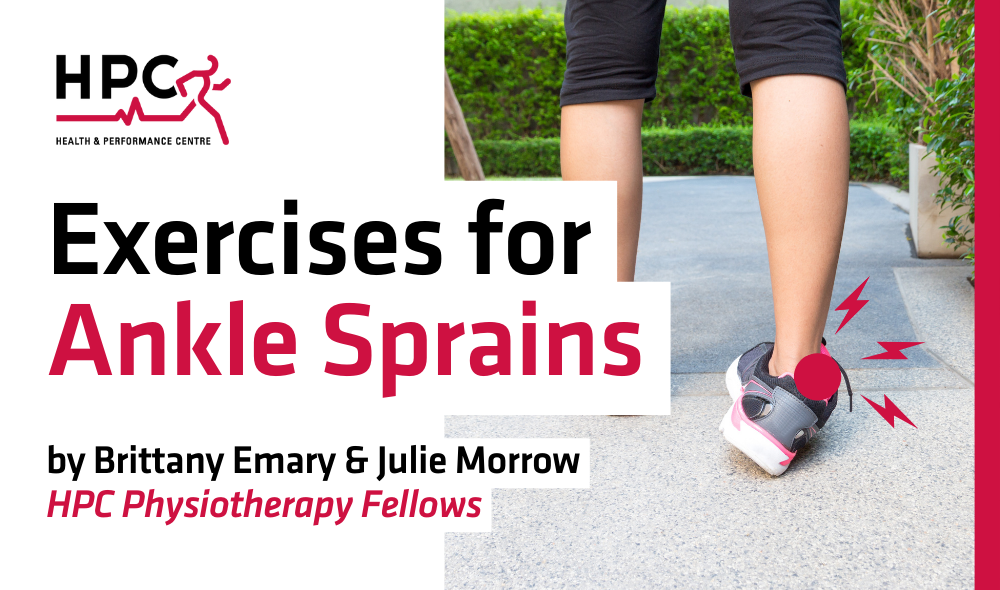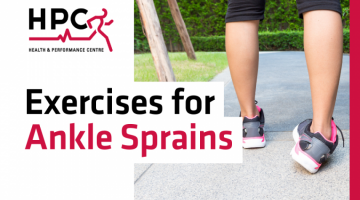Treating Ankle Sprains: Physiotherapy Exercises

What is an ankle sprain?
An ankle sprain occurs when the ligaments surrounding the ankle stretch beyond their limits and tear. The injury can vary from mild to severe, depending on how many ligaments are affected. This is a very common injury in people of all ages. Most commonly, there is a lateral ankle sprain, where the ligaments on the outside of the ankle are injured. Improperly treated sprains can result in weakened ankles, increasing the risk of recurrent injuries. This may lead to persistent issues like chronic pain, arthritis and instability.
How do ankle sprains happen?
-
Rolling the ankle inwards
-
Landing on an uneven surface (i.e. stepping down from a curb, awkwardly landing a jump)
-
Falling down or tripping
-
Participation in sports with running and jumping
What does an ankle sprain look like?
-
Pain
-
Swelling
-
Bruising
-
Tenderness, especially along the outside of the ankle
-
Inability to weight bear
-
Instability of the ankle joint
Diagnosing ankle sprains:
Ankle sprains can be diagnosed by a doctor or physiotherapist through a physical examination. X-ray or MRI scans may be needed to rule out a fracture or injury to nearby tendons or cartilage.
Treating ankle sprains:
Most ankle sprains are treated conservatively and do not require surgery. Usually after an ankle sprain, there is a period of rest and immobilization where ankle motion is limited. With moderate to severe sprains, a walking boot may be used. Compression, elevation, and icing of the ankle can be used to help with swelling and inflammation in the early phases of healing. After this phase, it is important to start moving the ankle by performing range of motion, isometric strengthening, and balance retraining exercises. Once the ankle becomes stronger and pain decreases, strength and balance activities can be advanced, and a gradual return to pre-injury activities can begin.
Home exercises for ankle sprains:
Ankle Alphabet: Lie or sit. With as big movements as possible, draw the letter A with your toes and ankle. Follow this with the letter B. Continue through all the letters.
Isometric Plantarflexion: Put a small ball against a wall and press the forefoot into the ball for 10-20 seconds. Keep your knees straight. The ball can be replaced with a rolled pillow if you do not have a ball.
Isometric Dorsiflexion: Sit with your legs stretched out. Place the opposite foot above the injured foot. Bring the foot back (dorsiflexion), while preventing movement from occurring by resisting with your other foot. Hold for 10-20 seconds, then relax.
Isometric Eversion: Sit with your legs stretched out. Place the opposite foot on the outside of the injured foot. Attempt to tilt the foot outwards (eversion), while preventing movement from occurring by resisting with your other foot. Hold for 10-20 seconds, then relax.
Isometric Inversion: Sit with your legs stretched out. Place the opposite foot on the inside of the injured foot. Attempt to tilt the foot inwards (inversion), while preventing movement from occurring by resisting with your other foot. Hold for 10-20 seconds, then relax.
Why is physiotherapy important?
Physiotherapy promotes a faster and more effective recovery after an ankle sprain. Targeted exercises enhance strength, flexibility, and joint mobility, alleviating pain and reducing swelling. Physiotherapists also focus on improving balance and proprioception, which is crucial for preventing future injuries and returning to sports and other activities you enjoy. Manual techniques help tissue healing, reducing the risk of chronic ankle problems. A personalized physiotherapy plan ensures a safe return to physical activities, reducing the likelihood of re-injury.
References:
https://orthoinfo.aaos.org/en/diseases--conditions/sprained-ankle/
https://www.rehabmypatient.com/ankle/ankle-sprains-medial-and-lateral
Written by: Brittany Emary & Julie Morrow, HPC Physiotherapy Fellows











